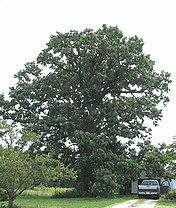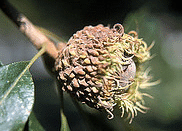Bur Oak Trees
Bur Oak, or Burr Oak, is also known as Mossycup Oak
Quercus macrocarpa Bur Oak
Zones: 3-8
Full to part sun
Height: 70-90’
Spread: 70-80’
Shape: Upright when young, developing a broad spreading canopy as it matures.
Growth Rate: Slow
Soil Preference: Adapts to a variety of soils from persistently moist to very dry, sandy to clay. Prefers an acidic or neutral pH. Will also tolerate some soil salt.
Moisture: Widely adaptable, very drought resistant
Foliage: Large 10-12” leaves, rounded lobes. The upper surface is dark shiny green, lighter gray green below.
Blooms: Male catkins and female tiny flowers
Fruit: Very large fringed acorns, about 1 1/2”
Bur Oak is massive and majestic, and everything about it is bold. The leaves are large and leathery textured. The acorns are massive and covered with a fringed cap, giving the Bur Oak it’s other name, Mossycup Oak. The bark become highly ridged and deeply furrowed. And the limbs are rugged from a massive trunk. A Bur Oak in winter makes a dramatic, gnarled statement in the landscape.
Bur Oak is native to the Upper Midwest and Central Plains, but is adaptable and grows well in nearly all the United States. After two or three years of growth Bur Oak develops a deep tap root, making transplanting difficult once it has begun. Bur Oak is actually in the White Oak sub-group, and is the most urban tolerant and fastest growing of the slow growing oaks. Bur Oak is not susceptible to Oak wilt and most pests will not affect it’s long term health. Maintain the tree’s health with regular spring fertilization and water in dry periods. Leaves turn brown to bronzy in fall.



